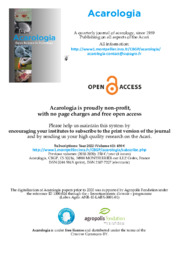Functional and numerical responses of the predatory mite Amblyseius aerialis (Acari: Phytoseiidae) to Aceria guerreronis (Acari: Eriophyidae).
Functional and numerical responses of the predatory mite Amblyseius aerialis (Acari: Phytoseiidae) to Aceria guerreronis (Acari: Eriophyidae).
Author(s): FERREIRA, C. T.; NORONHA, A. C. da S.; SOUZA NETO, E. P.; OLIVEIRA, R. P. de; LINS, P. M. P.; BATISTA, T. F. V.
Summary: The coconut mite, Aceria guerreronis Keifer, is one of the main pests of the coconut tree (Cocos nucifera L.) worldwide. Its control is mainly based on the use of acaricides. However, due to the habitat of this pest mite, which is protected by fruit bracts that act as a physical barrier, chemical control is often inefficient. Thus, natural enemies have been studied as an alternative to acaricides. We evaluated the functional and numerical responses of Amblyseius aerialis (Muma) to increasing densities of A. guerreronis (40, 80, 160, 240 and 360) and additionally the oviposition rates of the phytoseiid A. aerialis over 11 days on different food sources: coconut pollen, A. guerreronis and a mix of pollen and A. guerreronis. Our results showed that Amblyseius aerialis showed a type III functional response, where prey consumption increasing as the density of A. guerreronis increased, with a maximum consumption of up to 175 prey per predator. All the prey densities allowed female oviposition. The number of eggs laid by A. aerialis increased with increasing prey density and stabilized between 240 and 360 A. guerreronis individuals, with an average oviposition of 1.7 eggs/female. Furthermore, our results showed that all the food sources (coconut pollen, A. guerreronis and a mix of pollen and A. guerreronis) supported oviposition. The mean oviposition was approximately 1.5 eggs/female on all the food sources. Our study suggests that A. aerialis can be effective in the biological control of A. guerreronis. However, further studies are needed to investigate whether A. aerialis can explore the habitat of A. guerreronis and if that prey can support the development of immature stages and the reproduction of A. aerialis.
Publication year: 2022
Types of publication: Journal article
Unit: Embrapa Eastern Amazon
Keywords: Coco, Cocos Nucifera, Controle Biológico, Praga de Planta, Ácaro do coco
Observation
Some of Embrapa's publications are published as ePub files. To read them, use or download one of the following free software options to your computer or mobile device. Android: Google Play Books; IOS: iBooks; Windows and Linux: Calibre.
Access other publications
Access the Agricultural Research Database (BDPA) to consult Embrapa's full library collection and records.
Visit Embrapa Bookstore to purchase books and other publications sold by Embrapa.

